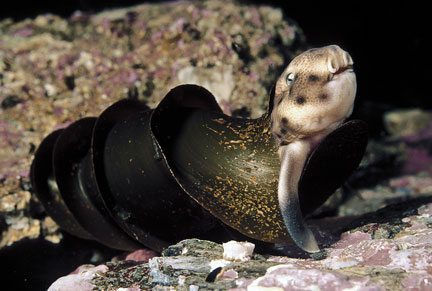This photograph of a hatching horn shark is one of my all-time favorites.
First of all, capturing the moment is extremely rare. For this reason, the image has value. Second, every time I see the photograph I am reminded of the benefits that are often enjoyed from doing some research and talking with experts. In this case, the expert was a scientist who helped me understand when and where I might get my shot.

Photo by Marty Snyderman
It is certainly possible to randomly encounter a hatching horn shark if you dive in Southern California at the right time of year, but you’d be up against some pretty long odds. However, if you set the goal of documenting a specific behavior, do your research, and pursue that goal with dogged determination, the odds just might turn in your favor. Might. The process of going after a specific shot as opposed to simply swimming around with your camera, firing away at anything you encounter can be a really fun part of underwater photography.
Keep in mind that there will likely be lots of dives when you don’t get the coveted shot. But stay at it. Knowing that success is not a certainty makes getting your shot that much sweeter.
For those of us fortunate enough to dive given areas repeatedly, we have the opportunity to really get to know how certain creatures live their lives. Taking advantage of that opportunity can take your underwater photography to new heights.
With regard to the image of the hatching horn shark, I captured it at Catalina Island, one of California’s eight Channel Islands and a very popular dive destination. Encountering horn shark eggs is not uncommon in Southern California. But it is extremely rare to come across one at the exact moment that a hatchling makes its way into the world.
In this case, a scientist friend of mine who had spent a lot of time studying horn sharks helped me locate an egg that he thought was “close” to hatching. So, just like a brood hen, I camped out on that egg. I was fortunate that the egg was in relatively shallow water. That meant long bottom times without having to worry about my no-deco limits or air supply. When it comes to capturing behavior, having time on your side is often the difference between success and disappointment.
A lot of people tell me how lucky I was to be in the right place at the right time to capture this photograph. I don’t dispute that luck played a big part. But I will also say that getting lucky took a lot of research, more patience than I’d imagined, and then it took four long days with lots of repetitive dives and what must have been several gallons of hot chocolate. But, finally, I enjoyed the sweet taste of success. And when I did, I suddenly felt wide-awake and all warm and fuzzy inside.



